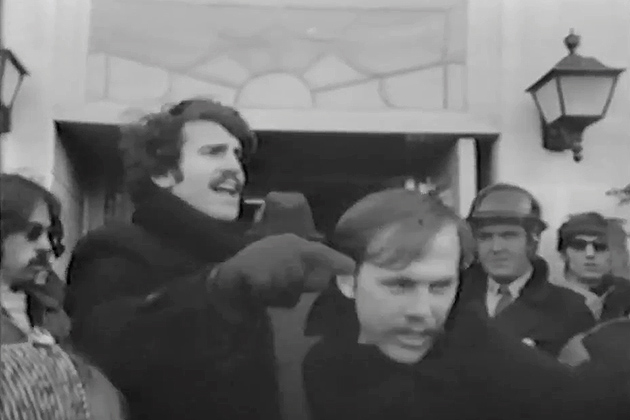
In writing about Homer D. Babbidge and his decade as UConn’s president, University historian Bruce M. Stave noted that the “cultural, political, and generational fault lines that widened throughout the nation during the tumultuous 1960s touched Storrs, emphatically dividing the first half of Babbidge’s tenure from the second.” (Red Brick in the Land of Steady Habits: Creating the University of Connecticut)
One of the flashpoints in Storrs during the Babbidge years occurred over a period of 10 days in the fall of 1968, when students and faculty protested on-campus employment recruiting by Dow Chemical Co. The company was the target of anti-war activity because it manufactured the chemical weapon napalm used by United States military bombers during the Vietnam War.
The dramatic behind-the-scenes struggle between Babbidge and the UConn protesters is the subject of a 1969 public television documentary that will be screened at the Benton Museum on Thursday, Feb. 6, at 7 p.m., in connection with the museum’s photo exhibition “Making the Movement Move: Photography Student Activism, & Civil Rights.”
Two camera crews worked independently for “Diary of a Student Revolution” to document the philosophies and strategies of the opposing sides on campus for National Educational Television (NET), the predecessor to the Public Broadcasting System (PBS), and its program “NET Journal,” the forerunner of today’s PBS shows “Frontline,” “POV,” and “Independent Lens.” Viewers are taken inside Gulley Hall, where University administrators discussed how to end the protests; into meetings, as students and faculty worked out their strategies; and outside to the sidewalks of the wintery campus, as students opposing the protests voiced their views. The protest was organized by members of the UConn chapter of the Students for a Democratic Society (SDS), a leader in the student activist movement at the time.

In one scene, an unidentified student is talking on the phone with campus police and asks for barricades to be set up so protesters would clearly know where they should stay without having to worry about being arrested or harmed. “These kids have absolutely no way of knowing if they do bump into any of your state policemen, he will not hit them,” he says of the troopers, who are seen carrying nightsticks.
In another scene, as Babbidge prepares to read an announcement to be broadcast over a telephone connection to the campus radio station, WHUS, he says: “The phone is off the hook … As a matter of fact, I wish I was off the hook at the moment.”
During a reflective moment in the film, Babbidge, who previously was a vice president for the American Council on Education, says, “To get caught in the kind of strategic relationship now with our critics is a most unhappy situation. I’m not a strategist. I wasn’t trained as a strategist. I have no stomach for it. Yet it seems to be a part of a college president’s job these days.”
The culmination of the protests occurred when eight students and four members of the faculty were arrested. One student leader of the SDS was suspended from classes and later reinstated with the others, who were placed on probation. Three of the four faculty were placed on probation.
***
The museum’s Balcony Study Gallery centers on images from the April 1974 occupation of Wilbur Cross Library, when about 200 students moved into the east wing of the building nearly two weeks after black students wrote to UConn President Glenn W. Ferguson asking for greater support for black organizations on campus. Their requests included improved minority hiring in faculty and staff, financial aid for minority students, and a new, larger space for the Afro-American Cultural Center, as the Center was known at the time. The photos are part of the University Photographs Collection in the Archives & Special Collections of the Thomas J. Dodd Research Center.
In the May edition of “Contac,” the Center’s newsletter, the situation was linked to scenes from the civil rights marches: “The sight of students being carried out forcibly by the police recalled the early sixties, when peaceful acts of dissent were dispersed by unnecessary force …”
Scenes from the previous decade recorded by photographers Danny Lyon and Ernest Withers, who both were active in the civil rights movement of the 1950s and 1960s, dominate the main gallery exhibition.

Lyon worked for the Student Nonviolent Coordinating Committee (SNCC) from 1962 to 1964, and Withers is known for his black-and-white images of the segregated South in the 1950s and 1960s, Negro League Baseball, and blues musicians in Memphis. The Withers photographs have been part of the Benton collection since 2006, and the Lyon images came to the Benton last year on loan from the Collection of Sheldron ’63 (CLAS) and Helen ’65 (CLAS) Seplowitz.

“Ernest Withers was a freelance photographer, and he started with the beginning of the civil rights movement, the 1957 integration of Little Rock High School,” says Ally Johnson, assistant curator at the Benton, who organized the exhibition. “He was close with Martin Luther King Jr. He photographed some of the marches after Dr. King’s assassination. His work brackets that time period.”
Among the Withers photos is a 1956 image of King with the Rev. Ralph Abernathy on the first desegregated bus ride in Montgomery, Ala., following the protests that took place after Rosa Parks was arrested for resisting bus segregation the previous year. A 1968 image by Withers shows a line of black men holding signs during a demonstration saying “I Am A Man.”
The Lyon images include a 1963 sit-in at a Toddle House restaurant in Atlanta and a 1962 demonstration at an “all-white” swimming pool in Cairo, Ill., as well as scenes from the Aug. 28, 1963 March on Washington.
![Danny Lyon. Untitled [Demonstrations at an "all-white" swimming pool in Cairo, Illinois], 1962. Collection of Sheldron and Helen Seplowitz.](https://today.uconn.edu/wp-content/uploads/2014/01/Lyon_05print.jpg)


